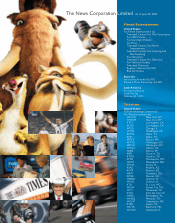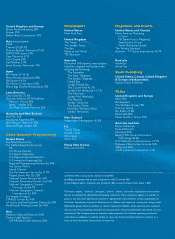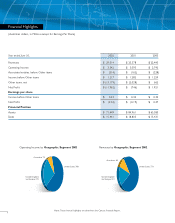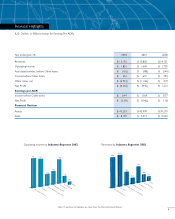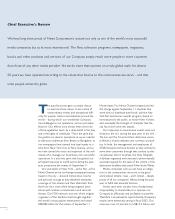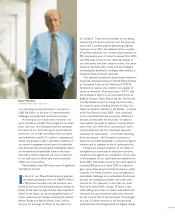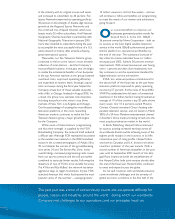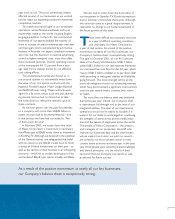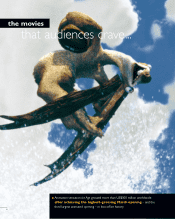Twenty-First Century Fox 2002 Annual Report Download - page 9
Download and view the complete annual report
Please find page 9 of the 2002 Twenty-First Century Fox annual report below. You can navigate through the pages in the report by either clicking on the pages listed below, or by using the keyword search tool below to find specific information within the annual report.
8
in the industry with its original movies and series
and increased its subscribers by 20 percent. Fox
Sports Networks improved its operating profit by
30 percent on the strength of double-digit revenue
growth at the Regional Sports Networks and
the continued rise of Speed Channel, which now
boasts nearly 52 million subscribers. And National
Geographic Channel, launched in partnership with
National Geographic Television in January 2001,
more than doubled its subscribers during the year
to accomplish the most successful rollout of a U.S.
cable network in history, after already achieving
great international success.
Meanwhile, our Fox Television Stations group
continued to thrive as the nation’s most enviable
collection of local stations – and the Company’s
most profitable business. In the past year we began
to realize the incremental benefits of our duopolies
in the top American markets as the group lowered
overhead costs, improved operating efficiency
and expanded its market share. Strategic acquisi-
tions and swaps during the fiscal year helped the
Company create four of those valuable duopolies –
with a fifth, in Chicago, finalized in August 2002. As
a result, the group now operates nine duopolies,
including duopolies in the nation’s top three
markets of New York, Los Angeles and Chicago.
Our focused strategy of creating the most efficient
television platforms in the most rewarding
American markets continues to make the Fox
Television Stations group a major growth engine
for the Company.
While much of these stations’ programming,
and thus their strength, is supplied by the FOX
Broadcasting Company, the network itself endured
a difficult year. Although FOX maintained its position
as the number two network in the 2002 broadcast
season in the coveted demographic of Adults 18 to
49, and despite the success of the groundbreaking
new series 24 and The Bernie Mac Show, lower
overall ratings, increased programming costs, losses
from our sports contracts and the soft ad market
combined to seriously hinder results. Following the
departure of two of FOX’s most durable hit series,
The X-Files and Ally McBeal, the network has taken
aggressive steps to regain momentum. In June, FOX
launched American Idol, which fast became the most
popular series of the summer – averaging nearly
10 million viewers in its first few weeks – and we
will continue to refine and redefine our programming
to meet the needs of our viewers and advertisers
going forward.
Our concerted efforts to improve our
businesses generated positive results far
beyond the U.S. In the U.K., BSkyB –
36 percent-owned by News Corporation – built on
its success as the best digital satellite television
service in the world. BSkyB’s phenomenal growth
led the platform to operational profitability by
the end of the year. The substantial increase of
Sky’s direct-to-home subscriber base, 6.1 million
strong by June 2002, fueled a 20 percent revenue
improvement. With annual revenue per user having
risen 11 percent and with churn impressively low,
Sky continues to set the operational standard for
digital television service everywhere.
STAR, too, achieved positive contributions for
the second half of the fiscal year as the pan-Asian
television platform improved its yearly operating
income by 57 percent. At the close of fiscal 2002,
STAR Plus celebrated two full years of unmatched
excellence in the Indian market, having broadcast an
average of 19 of the country’s top 20 cable shows
every week. Our 37.6 percent-owned Phoenix
Chinese Channel remained China’s leading inde-
pendent television service, and our launch in March
2002 of a 24-hour Mandarin entertainment channel
in Southern China made promising inroads into the
most populous television market in the world.
In Book Publishing, HarperCollins continued
its success, posting increased earnings across all
its worldwide divisions while achieving some of the
highest profit margins in the business. In its fifth
consecutive year of rising profits, HarperCollins
saw both its Canadian and U.K. divisions win those
countries’ publisher of the year awards. With a
record number of American bestsellers in the past
year, with its September 2001 launch of the bilin-
gual Rayo imprint and with the establishment of
the HarperCollins India joint-venture shortly after
the end of the fiscal year, HarperCollins continued
to excel and expand across the globe.
As I’ve said, however, with worldwide presence
come worldwide challenges, and the severity of
global economic conditions in the first half of the
The past year was a time of extraordinary events and exceptional difficulty for
people, nations and industries around the world - during which our worldwide
Company met challenges to our operations, and our principles, head-on.



